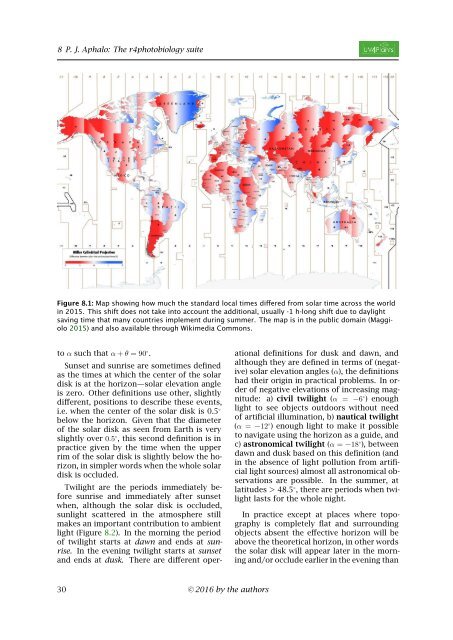UV4Plants Bulletin 2016:1
The Bulletin of the <a href="http://www.uv4plants.org>UV4Plants Association</a> is published two times per year. It is an open-access publication.
The Bulletin of the <a href="http://www.uv4plants.org>UV4Plants Association</a> is published two times per year. It is an open-access publication.
You also want an ePaper? Increase the reach of your titles
YUMPU automatically turns print PDFs into web optimized ePapers that Google loves.
8 P. J. Aphalo: The r4photobiology suite<br />
Figure 8.1: Map showing how much the standard local times differed from solar time across the world<br />
in 2015. This shift does not take into account the additional, usually -1 h-long shift due to daylight<br />
saving time that many countries implement during summer. The map is in the public domain (Maggiolo<br />
2015) and also available through Wikimedia Commons.<br />
to such that .<br />
Sunset and sunrise are sometimes defined<br />
as the times at which the center of the solar<br />
disk is at the horizon—solar elevation angle<br />
is zero. Other definitions use other, slightly<br />
different, positions to describe these events,<br />
i.e. when the center of the solar disk is 0.5 <br />
below the horizon. Given that the diameter<br />
of the solar disk as seen from Earth is very<br />
slightly over , this second definition is in<br />
practice given by the time when the upper<br />
rim of the solar disk is slightly below the horizon,<br />
in simpler words when the whole solar<br />
disk is occluded.<br />
Twilight are the periods immediately before<br />
sunrise and immediately after sunset<br />
when, although the solar disk is occluded,<br />
sunlight scattered in the atmosphere still<br />
makes an important contribution to ambient<br />
light (Figure 8.2). In the morning the period<br />
of twilight starts at dawn and ends at sunrise.<br />
In the evening twilight starts at sunset<br />
and ends at dusk. There are different operational<br />
definitions for dusk and dawn, and<br />
although they are defined in terms of (negative)<br />
solar elevation angles (), the definitions<br />
had their origin in practical problems. In order<br />
of negative elevations of increasing magnitude:<br />
a) civil twilight ( ) enough<br />
light to see objects outdoors without need<br />
of artificial illumination, b) nautical twilight<br />
( ) enough light to make it possible<br />
to navigate using the horizon as a guide, and<br />
c) astronomical twilight ( ), between<br />
dawn and dusk based on this definition (and<br />
in the absence of light pollution from artificial<br />
light sources) almost all astronomical observations<br />
are possible. In the summer, at<br />
latitudes > 48.5 , there are periods when twilight<br />
lasts for the whole night.<br />
In practice except at places where topography<br />
is completely flat and surrounding<br />
objects absent the effective horizon will be<br />
above the theoretical horizon, in other words<br />
the solar disk will appear later in the morning<br />
and/or occlude earlier in the evening than<br />
30 © <strong>2016</strong> by the authors



